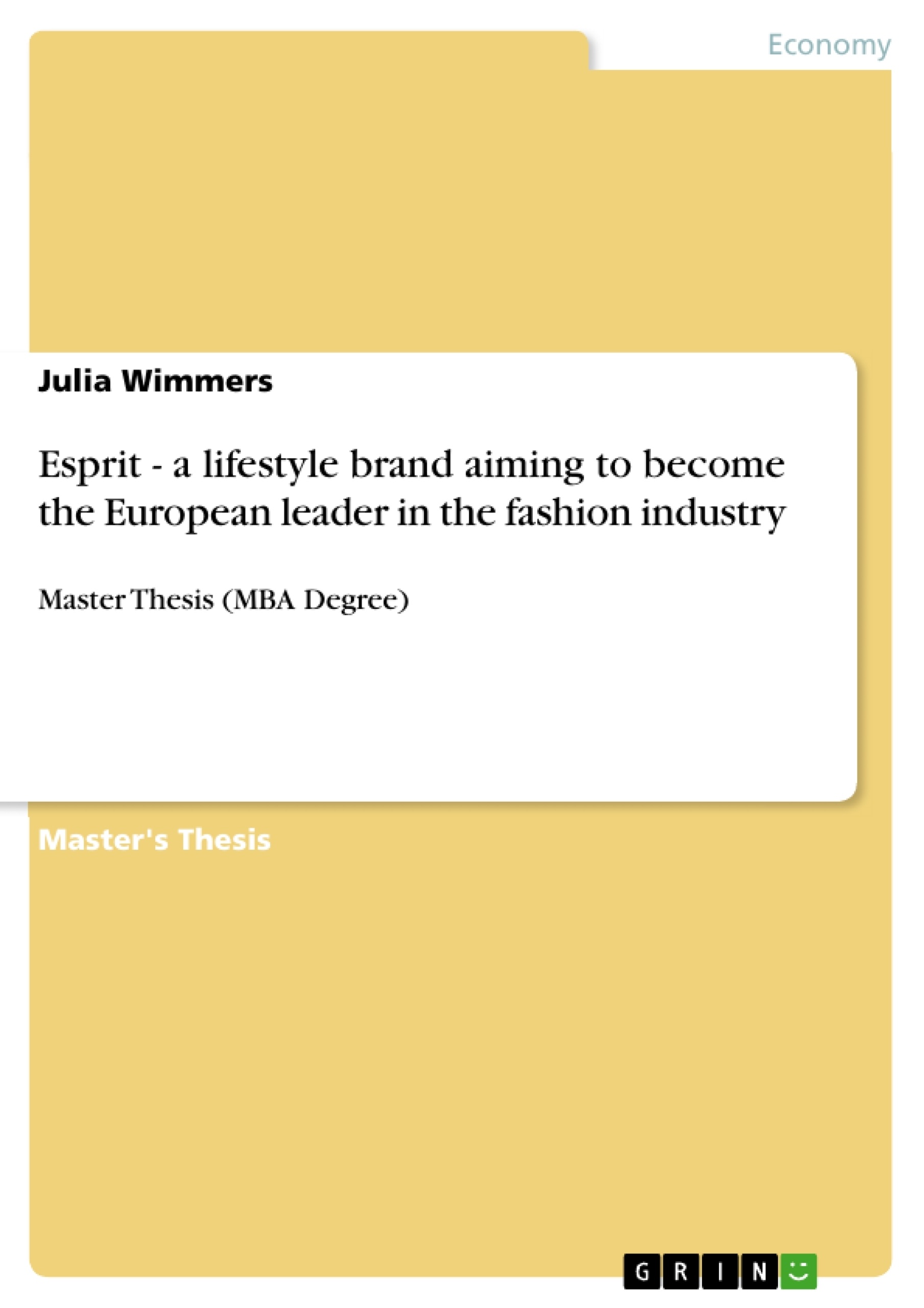Esprit a fashion and lifestyle brand founded in 1968 in San Francisco, California and its potential to become the leader in the European fashion industry is examined from an internal and external perpective, using a set of analytical and strategic tools. Beginning with general industry-related approaches and ending in a
detailed competitor analysis where for example ZARA, H&M and s.Oliver are closely analyzed with a portfolio evaluation and a nine-cell matrix for example. The business process within this industry
differentiates between retail and wholesale channels, selling various division lines mostly under heavy time and cost pressure. This is due to short fashion collection life cycles, high product
variety depending on fashion trends and styles that come and go. The high level of rivalry in the fashion market is characterized
through approximately 60 main competitors forming the strongest competition in the middle and premium price segment. Sustainability, POS experience worlds and celebrity collections do represent the most important commercial fashion trends, whereas from the sales channel perspective online shops are the dominating turnover contributor in the future followed by flagship and outlet
stores, both also having a strong growth potential.
Within the Esprit corporate brand profile the three brand value competencies “newness and style”, smart and international outfitter and customer focus are disclosed, which are inherited and
proven within a broad range of operative measures to increase sales figures and brand awareness.
However the competition is not always one step behind but often more than a step ahead, as the key performance indicators of H&M, s.Oliver, Benetton, ZARA and C&A do show up. From a financial view ZARA is in the lead in Europe with 7.07 Billion Euro, whereas H&M is very attractive for shareholders having paid a 2.17 Euro dividend per share and the Italian rival Benetton is ahead in country
presence being represented in 120 countries.
The contender Esprit dominates the fashion region “Central Europe” and is best practice in online shops. Nevertheless there is room for improvement and strategic adjustments in sales, marketing and distribution processes to match
new business opportunities in existing markets and new markets like Poland or Russia are necessary or strictly spoken unavoidable to achieve further growth in the future in order to fulfil Esprit’s entitlement: Europe is our fashion culture.
Table of Contents
- Executive Summary
- Table of Contents
- List of Abbreviations
- List of Figures
- Introduction
- Way of posing the problem
- Scientific and business objectives
- Implemented methodologies, analytical tools
- Review of essential concepts and definitions
- Industry Analysis
- Economical Situation Analysis
- Segmentation within Europe
- Trends in the world of fashion
- Factors driving the industry change
- Key Success Factors
- Esprit Company Profile
- Key Facts and Figures
- Brand Enhancement
- Sales Channel Optimization Factors
- Analysis of the main competitors and their strategies
- Performance Review of Major European Players
- Corporate Business Strategy evaluation of selected competitors against Esprit
- s.Oliver (SWOT, Financial Analysis, Portfolio Evaluation, Brand Performance)
- ZARA (SWOT, Financial Analysis, Portfolio Evaluation, Brand Performance)
- Esprit (SWOT, Financial Analysis, Portfolio Evaluation, Brand Performance)
- Substantiated Recommendations
Objectives and Key Themes
This master thesis examines the potential of Esprit, a fashion and lifestyle brand founded in 1968, to become the leader in the European fashion industry. It analyzes the industry landscape, key success factors, and the competitive environment to identify areas for improvement and strategic adjustments for Esprit.- Analyzing the European fashion industry landscape
- Identifying key success factors for the fashion industry
- Evaluating Esprit's brand performance and strategic position
- Analyzing the competitive landscape, including key competitors like s.Oliver and ZARA
- Developing recommendations for Esprit to achieve its strategic goal of becoming the European leader in the fashion industry
Chapter Summaries
- The introduction outlines the problem statement, research objectives, methodologies, and key concepts relevant to the study.
- The industry analysis section provides an overview of the European fashion market, including its economic situation, segmentation, trends, and key success factors.
- The Esprit company profile section presents key facts and figures about Esprit, its brand enhancement strategies, and its sales channel optimization efforts.
- The analysis of main competitors section focuses on the performance review of major European fashion players, including a detailed comparison of Esprit, s.Oliver, and ZARA through SWOT analysis, financial performance evaluation, and brand performance assessment.
Keywords
This master thesis focuses on the European fashion industry, analyzing key success factors, competitive landscape, and strategic positioning of Esprit, a lifestyle brand aiming to become the European leader. It explores the brand performance of major players like s.Oliver and ZARA, utilizing tools such as SWOT analysis and financial performance evaluation. Key concepts explored include vertical integration, brand enhancement strategies, sales channel optimization, and competitive advantages in the fashion industry.- Arbeit zitieren
- Julia Wimmers (Autor:in), 2011, Esprit - a lifestyle brand aiming to become the European leader in the fashion industry, München, GRIN Verlag, https://www.grin.com/document/182384



